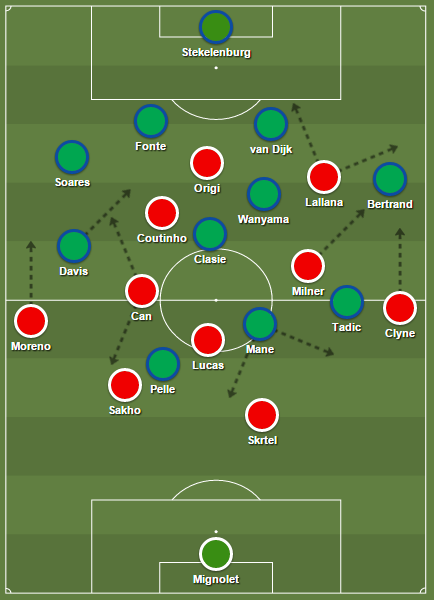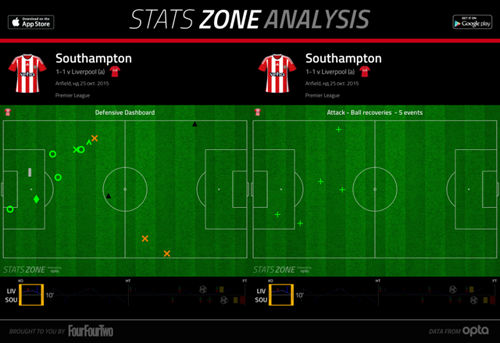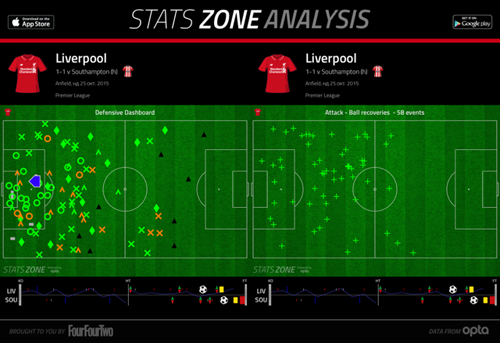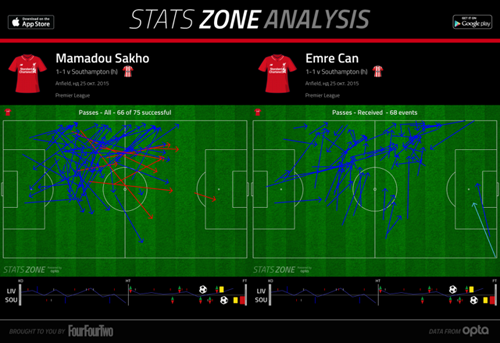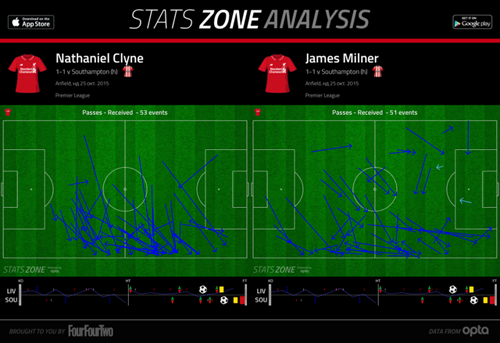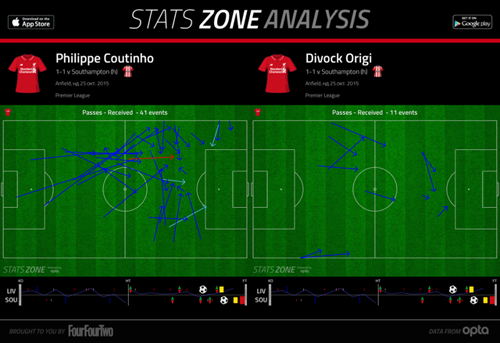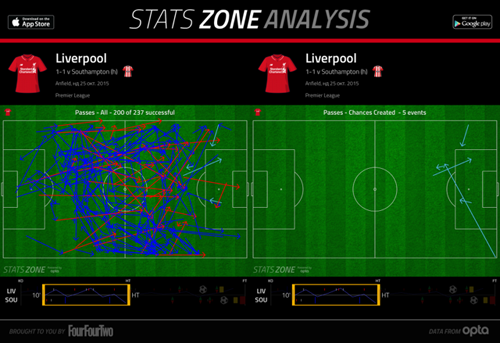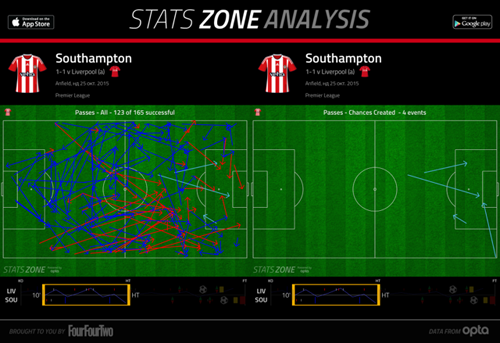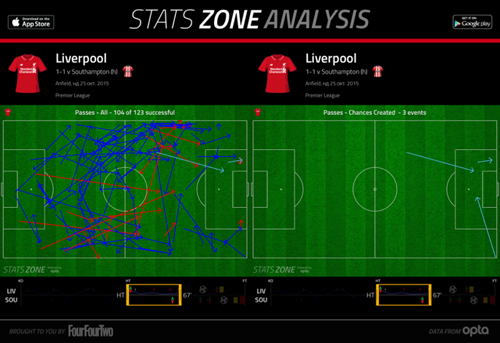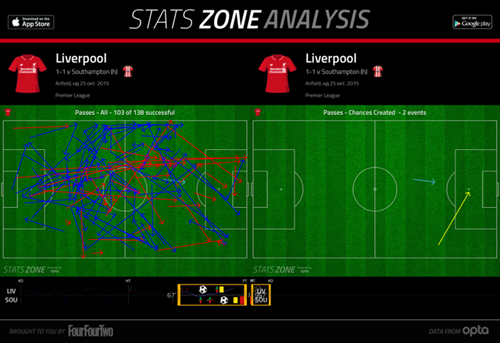By Mihail Vladimirov.
Summary
- Southampton sprang two initial surprises – fielding only one out-and-out defensive midfielder (Wanyama) and opting for a mass high press early on
- Saints’ high press didn’t really pay off, and they left spaces elsewhere as a result
- Once again Liverpool could not exploit the space that was opened up for them or convert enough of their play into goal-scoring chances
- Klopp toned down Liverpool’s pressing for their third game in 8 days
- Southampton dropped deeper, the game assumed its expected pattern
- How Klopp had his side function in possession going forward was fascinating
- In the second half, Benteke replaced Origi and Liverpool switched to attacking down the left
- This didn’t work as well as in the first half, and Klopp changed it again when Firmino came on for Lallana and the attacking went through the middle
- Southampton’s switch of Ward-Prowse for Tadic and moving Davis permanently to the right side blocked Liverpool’s central way through
For his third game in eight days, Klopp kept the same starting XI and 4-3-2-1 formation. Joe Allen, the only change from the Spurs game for the game against Rubin on Thursday, was now replaced by Lucas with both Firmino and Benteke remaining on the bench.
It was interesting to see how exactly Koeman would decide to approach this game formation- and personnel-wise. Unlikely Klopp, the Dutch manager had both the extra time and an almost fully fit squad to choose from. The surprising inclusion of Clasie in the starting XI made it look like Koeman preferred a 4-1-2-3 formation, but once the game started it become clear the visitors were going to use the same system as in their famous win at Chelsea a couple of weeks ago.
Southampton’s early gambles
The only change from their Chelsea approach was that unlike at Stamford Bridge, where Southampton started with both Wanyama and Romeu shielding the back four, Davis and Tadic narrow off the flanks and Mane playing in attack, just off Pelle, at Anfield Koeman started with only one natural holding midfielder, with Romeu replaced by Clasie, who is a spirited and battling player but ultimately a ball-player, a deeper-lying playmaker rather than a proper holding midfielder or ball-winner.
Not only did Koeman decide against bulking up his midfield zone with extra defensive cover, but he opted for a player (Clasie) who has just come back from a long injury lay-off and is yet to regain full match sharpness. This just shows the huge faith Koeman has in his fellow Dutchman for the future (effectively as Schneiderlin’s long-term replacement).
The potential issue here was that playing closer to a 4-4-2 formation with only one defensive-minded midfielder against a team expected to line-up with a plethora of midfielders, Koeman was effectively gambling on Wanyama holding the fort on his own. It was easy to imagine a scenario where the Kenyan was unable to do that against Coutinho and Lallana playing between the lines and with Can and Milner shuttling forward.
Obviously, Koeman was aware of that potential downside and had Davis always tucking infield from the right flank to effectively become the right-sided midfielder. This ended up like having two hard-working, defensively aware ball-winners either side of Clasie, which partially countered the possibility of only Wanyama being left to do all the defensive work in front of the back four. This gave Clasie freedom to often step up and press Liverpool from advanced positions, as the following chalkboard illustrates nicely:
The other gamble of Southampton’s initial approach was their frankly quite amazing willingness to press Liverpool not only from very high up the pitch but with at least five players. The front four and Clasie often got deep inside Liverpool’s half right from the first whistle, trying to close down Liverpool whenever the hosts attempted to build-up their play from the back. Sometimes the full-backs and/or Wanyama also followed suit and pushed forward in order to supplement the very advanced pressing.
Now, there’s nothing wrong with pressing so deep in the opposition’s half. The problem here was how Southampton tried to execute it rather than that they were trying that approach at all. The visitors’ 4-4-2ish formation was attempting to press a formation that has the midfield presence to easily outnumber them and work around the press.
As seen in the Rubin Kazan game, Liverpool tried to do the early build-up play by having the side midfielders dropping in either side of Lucas, who in turn went in between the centre-backs. On Thursday this allowed the full-backs to push really high down the flanks, effectively becoming the de-facto wingers. Here, with Southampton pressing so aggressively from the start, Moreno and Clyne remained a bit deeper. So not only did Liverpool have the 5-v-5 numbers to play out, but with the full-backs intelligently remaining in touch, the Reds – when necessary – were quick to create a 7-v-5 supremacy. All this meant it was simply impossible for Southampton to occupy all potential passing angles to then have a higher chance of all their pressing efforts bearing fruit. The visitors couldn’t really get close enough to their opponents to attempt to win the ball back as by the time a presser got closer to the ball, Liverpool have already moved it somewhere else.
As such Southampton were unable to either disrupt Liverpool’s passing rhythm and initial build-up play, nor force enough misplaced passes that led to a turnover of possession for them to set up dangerous counter-attacks. These are the two main aims usually associated with a high-pressing approach, and the visitors couldn’t achieve either. The most the Saints managed to benefit from was a few sloppy passes by Liverpool, which led to nothing dangerous, mainly because the home side had the numbers behind the ball to provide the required cover.
In fact Southampton didn’t really benefit from their high press in any way. Instead, in order to commit so many players to press forward, the visitors left plenty of gaps all over the place. Given the ease with which Liverpool bypassed their press and the fact Klopp’s team had the numbers congested through the middle with the full-backs quick to bomb forward, this was a recipe for the home side to exploit all that space on the break.
Several times inside the opening ten minutes Liverpool easily cut through Southampton and surged into all these gaps, both through the middle and down the channels. This was reminiscent of the Rubin game where the Reds were again gifted easy opportunities to break forward into free space. The difference was that on Thursday this happened because of how incompetently the Russian team looked to defend in their intended 4-4-2 defensive shape, while here it happened because Southampton’s gamble in pressing forward left themselves open at the back.
As in the Rubin game though, despite having close to a free run on the break, Liverpool simply couldn’t get the most out of such beneficial circumstances. As on Thursday, poor final passes, sloppy ball control in crucial moments, misunderstandings and lack of overall coordination were the main reasons why Klopp’s team’s dangerous breaks came to nothing. As early as the 3rd minute Liverpool had their best chance to punish Southampton on the break after they managed to beat their pressing and run forward on the break. Clyne bombed forward down the right then slipped the ball through for Coutinho on the edge of the box. If it wasn’t for Soares’ last-ditch block-tackle, the Brazilian’s shot would have surely at least have tested Stekelenburg.
Klopp tones down Liverpool’s pressing
One of the key questions regarding Liverpool’s tactical approach for this game was whether Klopp would continue to insist on his side pressing heavily whenever they were out of possession. As the game started it became clear the German manager had toned down his side’s pressing intensity.
Now, with Southampton pressing so keenly and from so high up the pitch, arguably there was no need for Liverpool to also press. As it happened, all the hosts had to do was to successfully pass around the press and set off on dangerous breaks. But once the visitors’ pressing faded away after the opening ten minute spell, there was an opportunity for the Reds to take command and start to press heavily themselves. That they didn’t do that even when the overall tempo slowed down suggested the reduced pressing intensity from the Spurs game was coming directly from Klopp. And arguably this was the right strategical decision, for fitness-related and tactical reasons.
This being the third game in eight days for all these players meant there is simply no way Liverpool could sustain heavy pressing for more than a very limited period of time (say 15-20 minutes). In addition, from a tactical point of view, it was arguably more beneficial to try and tempt Southampton forward by not looking to pin them back whenever they were on the ball. Instead of trying to break down a very well-drilled Saints’ side dropping in deep, narrow and compact defensive shape, Liverpool would’ve been wiser to let the game be more open and see their opponent have enough of the ball (without gifting them a commanding position) to provoke them into transitioning forward before trying to time the ball-winning activities and look to threaten on the break with all the potential space left in behind.
Liverpool adopted a similar defensive approach as in the Spurs game – logical, given it was the same 4-3-2-1 formation here too. As at White Hart Lane, when out of possession Klopp’s team tried to congest the centre to close off the space through the middle, which was designated to force the opposition to go down the flanks. But instead of pressing heavily once the ball was passed out wide, Liverpool did the same coordinated repositioning to move across and cut off all the obvious passing angles, but with drastically less intensity in their ball-winning activities and were more reactive. It was like Klopp’s team was content to give their opponent more time on the ball but not without first securing all the potential passing targets and after ensuring there was no meaningful space left uncovered through the middle or down the flanks.
This behavior was evident throughout the whole game too. Rarely did the home side attempt to press and win the ball back inside Southampton’s half, let alone inside their defensive third.
Southampton drop deep, Klopp’s attacking tweaks
The more often Liverpool managed to bypass the visitors’ pressing, the more often Southampton were left with holes at the back and were forced back to defend. By the 10th minute Koeman’s side had already dropped into a more permanent deep and narrow defensive block instead of committing the same numbers of players to press up ahead.
It felt like after watching his side get ripped apart a few times on the break, Koeman had ordered his side to keep players behind the ball in order not to leave as many gaps for Liverpool to exploit; especially as the heavy pressing wasn’t yielding any attacking benefits as a trade-off.
After the initial flurry of Southampton’s heavy pressing and Liverpool’s dangerous breaks during the opening ten minutes, the tempo slowed down and the game settled into the pattern expected before the game – the visitors defending deep and looking to threaten on the break, the home side dominating possession and territory and looking to find the breakthrough.
Koeman’s decision to have his side defend in what was a deep and somewhat asymmetrical shape, with Davis tucking in from the right to help through the middle and Tadic remaining wider to keep an eye on Clyne, was tactically interesting. But what proved even more fascinating was the way Klopp had his side function in possession going forward.
Liverpool’s set-up looked exclusively players-related – as it should be if you want to get the most out of the currently available resources. All was done to suit the players’ natural tendencies and individual capabilities.
As an overall attacking strategy it was clear the Reds had been tasked with directing the play mostly down the right-hand side and look to threaten in the final third mainly through that zone. But despite the clear emphasis down the right, the team remained aware of the need to also go down the left occasionally to mix it up and prevent being predictable and one-dimensional.
Starting from the back, Liverpool built-up the play mostly down the left-hand side due to the presence of Sakho and Can over that side. The former is clearly the team’s best ball-playing centre-back, while the latter is much more comfortable joining the recycling process from the back than Milner (which could easily be because of Can’s experience of playing in various roles across the back four and as a deep-lying midfielder).
However, more often than not Liverpool tried to channel the play down the right, either from the back (through Sakho) or once the ball reached the midfield zone (via Lucas). Down the right the team was already well prepared to pick up the ball and push forward due to the complementary presence of Milner and Clyne over there. Neither is a natural marshall of the whole flank on his own. The former has always been better linking-up with players overlapping him and/or drifting wide from central positions, while the latter is used to combining and overlapping past a wide partner who he can use as a reference in order to decide whether to bomb down the line or cut infield. Both players’ need to have a partner was provided with Milner continually drifting wider to interchange and interplay with Clyne. All this contrasted with the approach taken down the left side – there, Moreno was left solo and trusted to use his pace and directness on his own.
Milner drifting wide while Can remained central (shuttling up and down through the middle) wasn’t the only reason why Liverpool emphasised the right side in their attacking. It was also because of how well Lallana roamed towards the Milner-Clyne pair and joined them in some nice interplay on and off the ball.
All this helped further diversify the front trio. In contrast to the previous two games, Coutinho was roaming much better both by dropping deeper to join the build-up play and by pushing forward and occupying a more central position. With Lallana drifting to the right and playing the role of the semi-attacker who tried to sneak in and around the box, Coutinho was left as the de-facto advanced playmaker. Especially in the first half, the Brazilian showed signs of coming into form with some nice touches and movement interplay between the lines. Him getting more central also left space for Can to exploit with his sudden surges on his left.
Meanwhile, although not directly impacting his team’s attack, Origi played the important role of the roaming forward whose role was to be constantly on the run as a way to drag opposition players out of position and free up space for his teammates to exploit.
Still, for all their well-organised overall positional play and how well each individual’s role was assigned perfectly suited to the players, Liverpool couldn’t convert enough of their play into goal-scoring chances. However, in contrast to recent games (not only under Klopp but also during his predecessor’s), the team’s struggles weren’t because of a lack of proper tactical organisation and how the team was set up to function going forward.
Instead, here the issue was mainly one of execution. There were several genuinely promising situations that looked well set to develop into something threatening, but they ended up as ‘nearly there’ moments due to different individual malfunctions, misunderstandings or sloppiness on the ball.
The best illustration of what was good and bad in Liverpool’s play was the Lallana chance in the 32nd minute. Liverpool built-up the play from back to front and channelled in nicely down the right flank. From there, intelligent interplay saw the team work the ball dangerously in the final third and Lallana was fed into the box. But instead of controlling the ball and applying a dangerous shot on goal, he miscontrolled it and was forced to pass it backwards. A similar situation happened in the 17th minute, when after more good build-up play, Milner lofted the ball for Lallana in behind the defence, only for the latter to be flagged offside. There were several others similar attacking moves which frustratingly had the same end – being just ‘nearly in’.
It was the same for Southampton though. With Liverpool dominating and spreading out in attack, the visitors inevitably had their own chances to threaten on the counter-attack. But even with their own shortcomings in terms of providing the final pass or coordinating their movement better, Koeman’s side ended up with several ‘almost’ situations too. The best examples were Pelle’s inability to cushion the ball better with his head and set Mane free in behind Skrtel in the 29th minute, and five minutes later, after yet another dangerous break, Davis chipped the ball into the box to feed Mane, only for the forward to – similarly to Lallana – miscontrol it and let the chance slip away.
Start of second half, Liverpool on the left
At half-time Benteke replaced Origi, but this wasn’t the biggest change in how Liverpool played after the restart. Klopp’s team now changed their zone of attacking preference to down the left side.
Benteke proved an improvement on Origi mainly in how he directly impacted the way his team attacked. Instead of taking part in the overall movement interplay in the final third as Origi did in the first half, Benteke remained more static and was most dangerous when receiving long balls from deep which he then tried to lay-off to a player running off him. Meanwhile, Moreno also grew in terms of involvement, as the play was now coming more through his zone.
However, despite the above, it’s hard to say Liverpool’s second half strategy was more efficient than in the first half. The team was less fluid and cohesive in the final third than before half-time, mainly because Can isn’t naturally comfortable drifting wide and providing a secondary wide presence to Milner. Also, Coutinho does not have Lallana’s ability to ghost in and around the box when roaming off the ball. This meant the second half’s left-sided overload proved largely impotent when it came to fashioning chances.
Due to the increased involvement of Moreno but the decreased overall attacking fluidity and cooperation, Liverpool’s best ‘nearly’ moments in the second half all involved the Spanish full-back. First, in the 50th minute, following a throw-in, he and Lallana exchanged a good one-two to set him up nicely into the box, but he was flagged offside. Six minutes later one of the rare attacks down the right saw Clyne and Lallana work the ball well forward, before the latter’s cross ended up with Moreno on the opposite side. But instead trying to square it for Lallana, rushing into a tap-in position, the Spaniard produced something that arguably was an attempt on goal.
After another throw-in, in the 63rd minute, Coutinho sent a lovely through ball for Lallana into the box, but he was quickly surrounded by Southampton players and couldn’t produce a clean shot on goal.
Now, Klopp was arguably right to try something out as, despite the first-half approach working nicely as an overall structure and the players’ specific roles in it, the emphasis on attacking down the right didn’t lead to the desired effect of scoring goals. The question therefore is not whether Klopp should have applied further tweaks at half-time, but whether completely changing the approach was the right thing. There’s a case to be made that it could’ve been better stay with what worked but try to improve it. The introduction of Benteke and having him working to the right might have solved that better than ripping it up altogether and trying something that didn’t look as tactically sensible and suitable to the players as the first-half method.
Klopp changes it again
Seeing his side now struggle even more to find that breakthrough, it was only a matter of time before Klopp tried something else again. In the 67th minute he decided to replace Lallana with Firmino. At first glance this seemed to change little, but soon it became clear how Liverpool tweaked their approach.
From going down the right (in the first half), then on the left (at the start of the second half), perhaps it was logical to see Klopp now encouraging his side to stay central when trying to attack. With Firmino now the fresher player, it was perhaps expected that the majority of the attacks would flow through him – and he was playing largely through the middle.
However, by that time Koeman has already made a crucial substitution. From time to time he was ordering Davis and Tadic to swap places down the flanks, probably so he could have the more defensively capable Davis helping on both sides on a regular basis given the possibility of Liverpool’s 4-3-2-1 overload down both channels (as in the Rubin Kazan game). However, after he saw Liverpool switch from mostly going down the right in the first half to now mainly down the left, in the 64th he presumably decided it was time to make a tactical change, bringing on Ward-Prowse for the not-so-effective Tadic and switching Davis permanently to the right side, with Wanyama also going over there. Meanwhile Ward-Prowse’s job was seemingly to help solidify the centre of the pitch, helping the midfield pair deal with Liverpool’s numbers there. All this left Mane switching to the left, where he could act as the Saints’ de-facto counter-attacking outlet in the zone where Liverpool weren’t active going forward.
The way Koeman reshuffled his side meant Liverpool’s attempt to now go mostly through the middle was doomed to failure due to Southampton already applying the above changes to end up having the numbers and suitable personnel to cope with it. Apart from a hopeful Coutinho long shot, Benteke’s goal was the hosts’ only meaningful chance in the final near half hour after Firmino came on. And the irony was that the goal actually happened with Liverpool going down the right and using the Clyne-Milner pair, with the latter swinging in a sublime cross for Benteke to head home.
To the end of the game
Something that is worth highlighting separately is Koeman’s tactical bravery in the last 15 or so minutes.
What seemed strange is that Clasie remained on the pitch so long before (until finally replaced in the 76th minute). For a player lacking match sharpness, having just come from a long period injured, and asked to fulfil such a physically and mentally demanding role as the other part of the double pivot unit, it was peculiar why he wasn’t replaced earlier.
However, by the time he was subbed off, it was clear Liverpool had started to become increasingly leggy and fatigued – which was logical given this was their third game in 8 days. Interestingly, when Clasie was eventually replaced, Koeman made a full-blown attacking reshuffle by introducing a second forward (Juanmi) to play around Pelle, with Ward-Prowse coming deeper next to Wanyama. It was as though Koeman, seeing Liverpool becoming more and more pedestrian, seized the opportunity and decided to use his side’s freshness to push on and try to nick victory in the final 15 or so minutes.
But a minute later came Benteke’s goal, and Koeman’s admirable bravery could be said to have backfired, but also came in handy as now his side had to chase an equaliser. But as in the opening 10 minutes, despite taking a gamble and being attack-minded, the away team just couldn’t make the most of having so many attack-minded players on the pitch (in the 80th minute Ramirez replaced Davis, with Southampton going with a proper 4-2-4 formation).
Part of this was because of Klopp’s decision to go defensive and switch to a 4-5-1ish formation in the 83rd minute. Ibe replaced Coutinho, with he and Milner now going down the flanks and Firmino slotting deeper next to Lucas and Can. Liverpool defended well in open play and if it wasn’t for their series of individual sloppiness defending Southampton’s free-kick, they may well have won the game.
Post-match thoughts
Although this was far from a vintage Liverpool, let alone something resembling a peak Klopp team, the game showed signs of improvement. The Reds defended as well as in the previous games in open play but here, their attacking play was a few steps ahead of what they produced in Klopp’s first two games in charge.
The first half’s structure and how well the players’ roles were identified within it, taking into account what suits each player, was the biggest shining light. That the team failed to convert it into a series of goal-scoring chances shouldn’t be a worry, especially as the failure was due to individual malfunctions rather than anything tactically related (as was too often the case in the past 18 months at least). However, the second half represented more chaotic tactical thinking with Klopp trying out new things, when arguably it could’ve been better if he stayed on course and looking to simply improve on the first-half display (going 4-diamond-2 and retaining Origi was an option too).
As a whole this was a game best characterised with the plenty of ‘nearly’ moments produced by both teams. As such a draw was a fair and fitting way for it to end.
